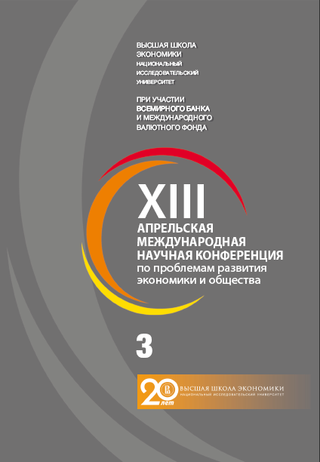?
Сегментация в маркетинге жителей российских городов
Гл. 3. С. 336–345.
Rozhkov K. L., Skryabina N.
The purpose of the study - identification and systematization of factors of place attractiveness for inhabitants (quality of local life). Research method is a survey of the population of the five cities of the Republic of Karelia. The most important results and conclusions of the study: place attractiveness depends on both objective factors of the local environment and the perceptions of local population. Perception, in turn, is formed by the existing local way of life.
In book

Кн. 3. , М.: Издательский дом НИУ ВШЭ, 2012.
Rozhkov K. L., / NRU Higher School of Economics. Series MAN "Management". 2012. No. 05.
The paper shows relationships between characteristics of residents and places where they live. A combination of three criteria of place attractiveness (retention and attraction, conditions for natural growth, and settling) was chosen to classify place market segments, and profiles of beneficiaries for all the segments on the theoretical level were built. The results of the ...
Added: March 24, 2013
Rozhkov K. L., / NRU Higher School of Economics. Series MAN "Management". 2012. No. 02.
Inhabitants become the important target group of place marketing along with other place consumers.
The problem of defining criteria for the attractiveness of places for different inhabitants and classification of factors is one of the most important for the marketing policies aimed at development of local communities.
The paper shows that the combination of three criteria of ...
Added: July 25, 2012
Rozhkov K. L., В кн.: Удовлетворенность потребителя. Эмпирические исследования и практика измерения.: М.: ИНФРА-М, 2013. Гл. 1.7 С. 103–116.
Residential satisfaction with opportunities for living usual lifestyle is an important place attractiveness factor. The empirical study demonstrates a relationship between evaluations of attributes profiles of five Russian towns and attractiveness of these towns which is measured by spatial behavior indicators. ...
Added: September 13, 2013
Rozhkov K. L., / NRU Higher School of Economics. Series MAN "Management". 2012. No. 06.
The paper shows relationships between level of residential satisfaction and form of differentiation of marketing policy in place market segments. A combination of three criteria of place attractiveness (retention and attraction, conditions for natural growth, and settling) was chosen to classify place market segments, and distribution of residents by the level of satisfaction as a ...
Added: March 24, 2013
Rozhkov K. L., Skryabina N., Journal of Place Management and Development 2015 Vol. 8 No. 2 P. 103–122
Purpose – This paper aims to develop a theoretical approach to place market analysis that aims to identify the ways in which specific places are used and to further enable the identification of distinct segments and products. Design/methodology/approach – Typology construction was chosen as the main study method. Eight polar place demand patterns were classified ...
Added: March 19, 2015
Rozhkov K. L., В кн.: Современные потребительские тренды и удовлетворенность потребителяТ. 1.: М.: ИНФРА-М, 2013. Гл. 2.5 С. 68–83.
Place attractiveness is considered as a combination of its ability to attract new residents, retain existing residents, and promote the natural growth of the population and settling of the natives. The complex category reflects residential satisfaction, on the one hand, and efficiency of place marketing, on the other. Being measured through spatial behavior indicators, it ...
Added: September 13, 2013
Железнодорожный терминал. "Жизнь - это ожидание", или московский вокзал глазами скучающего пассажира
Gudova E. A., Nefedova A., Laboratorium. Журнал социальных исследований 2016 Т. 8 № 2 С. 120–138
In this essay the authors present the results of a Moscow railway terminal study as an example of “non-place,” when presence in the space can be reduced to the amount of time spent passing through it. Using Viacheslav Glazychev’s concept of urban environment quality, the Kazan’ Railway Station environment was evaluated through observation. The methodological ...
Added: September 25, 2016
Rozhkov K. L., Khomutskii K., International Studies. Interdisciplinary Political and Cultural 2019 Vol. 24 No. 2 P. 11–25
The paper shows relationships between characteristics of residents and places where they live. A combination of three criteria of place attractiveness (retention and attraction, conditions for natural growth, and settling) was chosen to classify places, and profiles of their beneficiaries on the theoretical level.
The results of the empirical study partially confirm developed theoretical typologies. Two methods ...
Added: November 24, 2019
Rozhkov K. L., Скрябина Н. И., В кн.: Современный менеджмент: проблемы, гипотезы, исследования. Сборник научных трудов. Выпуск 4. В 2 ч.Ч. 2. Вып. 4.: М.: Издательский дом НИУ ВШЭ, 2012. С. 336–345.
quality of living ...
Added: September 13, 2013
Sheresheva M. Y., Sharko E., Современные проблемы сервиса и туризма 2020 Vol. 14 No. 2 P. 7–17
The article discusses the role of customer experiences provided by theme parks that are a special kind of tourist attraction forming a unique tourist product. The goal of the study is to identify promising ways to boost the quality of theme park design and service in Russia. A systematic and situational approach, as well as ...
Added: September 20, 2021
Sazhina A., Научные труды Вольного экономического общества России 2014 Т. 189 С. 127–132
The article defines the importance of studying the residents’ equity in place marketing. Several current approaches to determining the residents’ equity are highlighted. In conclusion, the approach to determining the residents’ equity in place marketing is stated. ...
Added: February 19, 2015
Sazhina A., , in: Inter-Regional Place Branding. Best Practices, Challenges and Solutions.: Dordrecht, L., Heidelberg, NY, Cham: Springer, 2015. Ch. 5 P. 51–63.
In Chap. 5, Aleksandra Khamadieva presents a “Development of a methodology for measuring the residents’ utility within place marketing”. Focusing on the important target group of residents, the author investigates which factors are most important for a place and how those can be measured. These questions become even more complicated in the context of interregional ...
Added: June 3, 2015